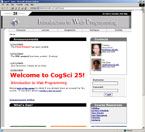 |
|||||||||||
|
COGS 187A - Multimedia Design (1)
This class consists of lectures and labs designed to work together to introduce the student to the dynamic field of web design and information architecture. The lectures will present and examine key issues that thoughtful designers need to understand to improve user experience. Initial help on HTML programming will be available during lab sessions, but overall the course is setup to help students find the programming tutorials and help they need on the web.
At the end of this course you should have a basic technical competence in html coding, simple javascript, cascading style sheets, and usability evaluation. At a more theoretical level you should understand the core principles of information architecture, understand the influence of layout on comprehension, the pros and cons of using hypertext in communication, and glimpse the possibilities of new narrative structures.
Course
Website |
||
|
||
The beginning of the course starts with a brief review of the basics of HTML and CSS. The students then apply their knowledge of HTML and CSS to the following theories of multimedia design.
Site Design
Information Architecture
Information architecture is the construction of
a structure or the organization of information. On the Web, information
architecture is a combination of organizing a site's content into categories
and creating an interface to support those categories. From site navigation
to designed "spaces," an effective information architecture
leads to more usable Web-based networks.
Metaphors
Metaphor is a mechanism for shaping expectations. It uses similarity to
cases we already know about to help us through new situations. Using metaphors
in novel situations provides you with much needed hints, advice, and enough
constraint or a sufficiently intuitive context of action to make it obvious
what to do.
Navigation
Designers have a variety of organizational principles they can apply to
design a site to be easily navigable. Navigation is about being able to
find by traversing links. The labels, links and graphics that help users
browse through a system.
Theory
Hypertext
Hypertext is the language that links the Web. On
Web pages, hypertext is anything that is "clickable" - text,
images, music, applications, etc. For example: you use links and anchor
tags to create hypertext on Web pages. All these things are linked together
in a non-linear manner.
Interactivity
Humans interact in all sorts of surprising ways
with texts, and as designers we need to understand these to create good
page layouts and good web sites.
Usability
Heuristics
Usability is about experience - the feeling of being able to do what you
want to do easily, comfortably, without mental strain. Heuristic evaluation
is a quick way to determine what is wrong with a site. What follows is
a lecture on the main ideas of heuristic evaluation.
Task Analysis
Task analysis is a way of determing how effectively transactions are designed. A well conceived task analysis can help designers determine the required interface and interaction design for transactions, and web site owners determine how well designed the transactions are compared with other sites. They need to continually understand how each and every transaction works.
|
|
|
|
|







